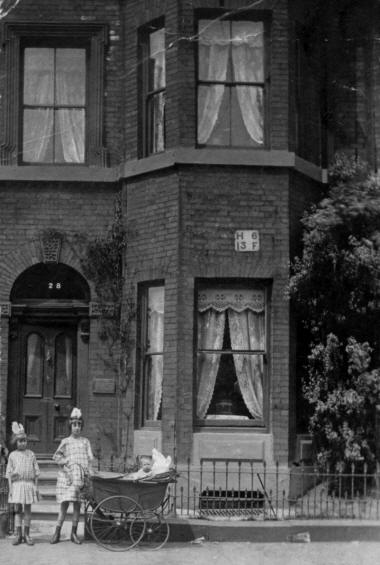
| Early Memories #2 | HISTORY Page | Obituary Page | |
| |||
Walking along Brunswich Street to the university is always a slightly unnerving process for me. Everything seems wrong: what I see today is at odds with the Brunswick Street I know and experienced. I grew up in the Manchester of the 1920s, when the street presented an almost solid front of respectable Victorian terraced houses, stretching from the park at Ardwick Green to Owens College on Oxford Road, a facade interrupted only the the stone-built bulk of St. Paul's church on Temple Street corner and scattered cases of shops. The tramlines ran along the centre of the street, with only the occasional motor car passing by, spreading the droppings from the horses which still drew most of the vehicles on the road.
The sun shone the day the photograph was taken; almost directly overhead, according to the underfoot shadows. I'm in the care of my two youngest aunts, schoolgirls in gingham dresses, with sturdy button-up boots and short socks, each topped by a huge white bow in their hair: Molly relaxed and holding on to the pram handle and Hilda, perhaps a little bored with posing, self-consciously stiff, arms at her sides. Oddly, we don't seem to be the subject of the photograph, since our small group is relegated to the lower left-hand corner of the picture. What dominates the scene is the house: the vertical column of the lace-draped bay windows, with the obligatory aspidistra blocking the view into the front parlour, flanked on the right by an overgrown privet bush reaching up to the bedroom windowsill, and on the left by the front door, the house number prominently displayed in its semi-circular light, topped by a creeper ambitiously climbing roofward. An iron railing separates the narrow front garden from the pavement, and the gate behind my aunts opens on to a flagstoned area with the coal-grid at its centre in front of four large steps up to the wide front door surmounted with a semi-circular fanlight bearing the house number. A brass plaque at the side of the door announces that this is Britannic Assurance Co. The photographer must have positioned his camera on the opposite pavement, relying on a quiet period in passing traffic to capture this all-encompassing view. I know that behind him is one of the curiosities of Brunswick Street in those days--the premises of John Ward, a faith healer of some standing in the community. He occupied one, or was it two houses, providing a temple of healing and a place for pilgrimage for the ailing and afflicted... and there was no shortage of them in the years following the first world war. I recall the place vividly because it dominated our end of the street. The house front had been painted completely black and the name of John Ward and messages proclaiming his prowess and accomplishments as a "natural healer", with a list of esoteric diseases and ailments from which paying clients might expect to be cured by the application of "magnetic heat", ran in huge white letters over the entire surface. In a gullible age, he attracted a large clientele and was one of the few residents able to travel in his own chauffeur-driven car. Hearsay reported remarkable cures of consumption, pneumonia and even blindness. It was common knowledge that before opening up on our street, he'd practiced in nearby Bolton, home of the famous Bolton Wanderers team, where he was popular among players because he specialised in the treatment of the prevalent complaint of "loose cartilage". The officially appointed doctor took umbrage at this invasion of his preserve and was said to have prevailed upon the team directors to boycott Ward's activities and ban him from treating any of the team. So the healer brought his talents to the metropolis and prospered. I've never got around to checking on the performance records of Bolton Wanderers before and after John Ward's departure from the scene. I'd be interested to hear the results if some curious local historian were to do so. ■ © Harry Turner, May 1997
|
 |
 I started life in my grandparents' house at number 28 before my family moved along to number 24. Memories of the tall red-brick houses are preserved for me in an intriguing photograph that has survived from those days. On it, I gaze out, propped up on plumped-up pillows, from a sturdy boat of a pram, suspended on a well-sprung frame and giant wheels guaranteed to ride over the highest kerbstone without a jolt, equipped to cope with the worst that Manchester's weather can offer, with a folding hood and the optional extra of a basketwork umbrella holder conveniently located at the handle end.
I started life in my grandparents' house at number 28 before my family moved along to number 24. Memories of the tall red-brick houses are preserved for me in an intriguing photograph that has survived from those days. On it, I gaze out, propped up on plumped-up pillows, from a sturdy boat of a pram, suspended on a well-sprung frame and giant wheels guaranteed to ride over the highest kerbstone without a jolt, equipped to cope with the worst that Manchester's weather can offer, with a folding hood and the optional extra of a basketwork umbrella holder conveniently located at the handle end.